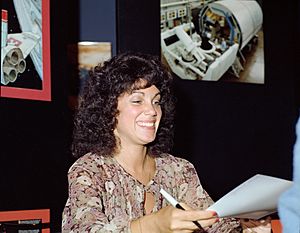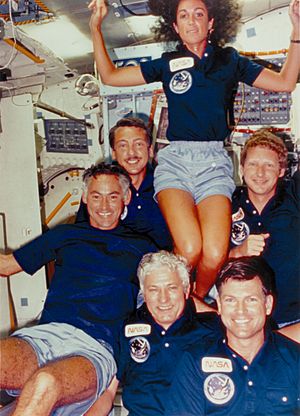Judith Resnik facts for kids
Quick facts for kids
Judith Resnik
|
|
|---|---|
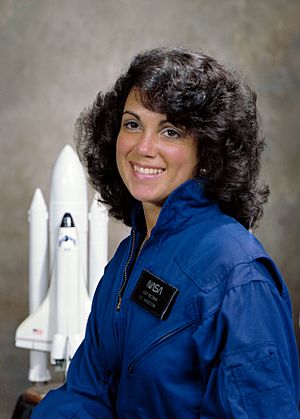
Official portrait, 1978
|
|
| Born |
Judith Arlene Resnik
April 5, 1949 Akron, Ohio, U.S.
|
| Died | January 28, 1986 (aged 36) North Atlantic Ocean
|
| Resting place | Arlington National Cemetery |
| Alma mater | Carnegie Mellon University (BS) University of Maryland (PhD) |
| Occupation |
|
| Awards |
|
| Space career | |
| NASA astronaut | |
|
Time in space
|
6d 00h 56m |
| Selection | 1978 NASA Group |
| Missions | STS-41-D, STS-51-L (Space Shuttle Challenger disaster) |
|
Mission insignia
|
 |
| Scientific career | |
| Thesis | Bleaching Kinetics of Visual Pigments (1977) |
| Doctoral advisor | Felix E. Zajac III |
Judith Arlene Resnik (born April 5, 1949 – died January 28, 1986) was an American electrical engineer, software engineer, biomedical engineer, pilot, and NASA astronaut. She is known for being the fourth woman and second American woman to fly in space. She was also the first Jewish woman of any nationality to fly in space. Judith spent 145 hours orbiting Earth. Sadly, she died during the Space Shuttle Challenger disaster.
Judith was recognized for her amazing intelligence from a young age. She was accepted into Carnegie Mellon University after achieving a perfect score on the SAT exam. She was only the sixteenth woman in U.S. history to do so! She earned a degree in electrical engineering from Carnegie Mellon. Later, she received her PhD in electrical engineering from the University of Maryland.
Before becoming an astronaut, Resnik worked as an engineer for RCA. There, she worked on Navy missile and radar projects. She also worked as a senior systems engineer for Xerox Corporation. She even published research about special computer circuits. Judith was also a pilot and contributed to biomedical engineering research. She worked as a research fellow at the National Institutes of Health.
At 28, NASA chose Resnik as a mission specialist. She was part of NASA Astronaut Group 8, the first group to include women. During her astronaut training, she helped develop software and procedures for NASA missions. Her first space flight was the STS-41-D mission in 1984. This was the twelfth Space Shuttle flight and the first journey of the Discovery. Her job included operating its robotic arm. Her second Shuttle mission was STS-51-L in January 1986 aboard the Challenger. She died when the Shuttle broke apart shortly after liftoff.
Contents
Early Life and Education
Judith Arlene Resnik was born in Akron, Ohio, on April 5, 1949. Her father, Marvin Resnik, was an optometrist, and her mother, Sarah, was a legal secretary. She had a younger brother named Charles. Judith grew up in a Jewish home. She studied at Hebrew school and celebrated her Bat Mitzvah in 1962. This was not very common for girls at that time.
Judith's intelligence was noticed early on. She started elementary school a year ahead of schedule. She attended Fairlawn Elementary, Simon Perkins Junior High, and Harvey S. Firestone High School. She was an excellent student, especially in math, languages, and piano. She even considered becoming a concert pianist. Before college, she achieved a perfect score on her SAT exam. She was the only woman in the country to do so that year. She graduated from Firestone in 1966 as the top student (valedictorian).
At 17, Resnik entered Carnegie Institute of Technology. She joined the Alpha Epsilon Phi sorority. She first planned to study math. However, in her second year, she found a passion for electrical engineering. She was one of only three female students in that field. Judith was also a great cook and enjoyed navigating in sports car rallies. She earned a Bachelor of Science degree in electrical engineering in 1970. She was also a member of two honor societies, Tau Beta Pi and Eta Kappa Nu.
After graduating, Resnik worked for RCA as a design engineer. She worked on missile and radar projects. She also developed electronics and software for NASA's rocket and telemetry systems. An academic paper she wrote about special computer circuits caught NASA's attention. She continued her studies, earning her PhD in electrical engineering in 1977 from the University of Maryland. Her research focused on how electrical currents affect the retina in our eyes.
Becoming a NASA Astronaut
Selection and Training
After finishing her PhD, Judith became a senior systems engineer for Xerox Corporation in Los Angeles. A friend encouraged her to apply to NASA. She also met with former astronauts Michael Collins and John Glenn. To strengthen her application, she earned a private pilot's license in 1977. She scored almost perfectly on her flying exams!
In January 1978, at age 28, Resnik was chosen by NASA as a mission specialist. She was one of twenty-nine men and six women selected. This was the first time NASA chose women to be astronauts. Her new salary was less than what she earned at Xerox, but she was excited. Her fellow astronaut candidates nicknamed her "JR." She trained very hard, focusing on her physical fitness. She also piloted the Northrop T-38 Talon, a jet used by astronauts for training. Astronaut Jerome Apt called her "an excellent pilot."
Resnik worked on orbital systems, flight software, and spacecraft control. She helped develop the software and procedures for the Space Shuttle's Remote Manipulator System (RMS), which is a robotic arm. She also worked on systems for deploying satellites. She didn't enjoy the public appearances that came with her job. She preferred to avoid TV interviews and questions about her personal life.
First Space Mission: STS-41-D
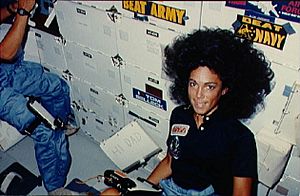
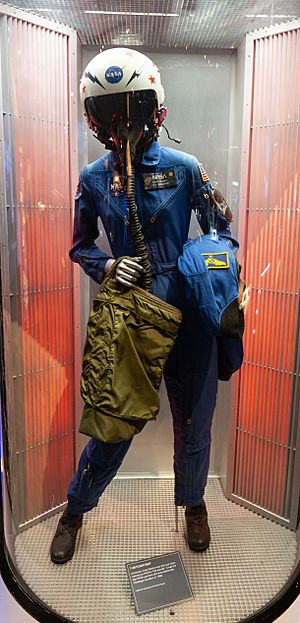
In February 1983, Resnik was assigned to the crew of STS-41-D. This was the twelfth Space Shuttle flight and the very first journey of the Space Shuttle Discovery. Her crewmates included Henry Hartsfield, Michael Coats, Steven Hawley, and Mike Mullane. Resnik was a big fan of actor Tom Selleck. Her crewmates even hid a poster of him behind the bathroom curtain on Discovery as a joke!
The launch of STS-41-D was delayed three times. The first two attempts were stopped due to computer and engine problems. This was the first time a NASA mission had to stop its engines after starting them since 1965. Finally, on August 30, 1984, Discovery successfully lifted off. Judith's family watched the launch from a special viewing area.
Judith Resnik became the second American woman in space. She was also the first American Jewish astronaut and the first Jewish woman to go into space. Her main job was to operate the Space Shuttle's robotic arm. She was an expert on it, as she had helped create it. On the first day, Resnik and Mullane deployed a satellite for Satellite Business Systems. The next day, they released another satellite for the U.S. Navy. During this, Resnik's hair got caught in an IMAX camera! The crew fixed it, and she kept her distance from the camera after that. They deployed a third satellite the following day without any problems.
Resnik also deployed a large solar array wing. This experiment was to test new ways of generating more power in space. She reported that the experiment worked well. During the mission, she held up a sign that said "Hi Dad" to the cameras. In a live TV broadcast, she told President Ronald Reagan that "the Earth looks great." After the mission, her commander, Henry Hartsfield, called her the "astronaut's astronaut." Discovery landed on September 5, 1984, after a flight of 6 days and 56 minutes.
Space Shuttle Challenger Disaster
On January 29, 1985, NASA announced that Resnik would be on the crew of STS-51-L. The main goal of this mission was to launch a new Tracking and Data Relay Satellite. It would also carry a special telescope to study Halley's Comet. Resnik was in charge of the robotic arm and would deploy and retrieve the telescope. The flight also included Christa McAuliffe, a teacher chosen for NASA's Teacher in Space Project. Resnik was part of the team that spoke to the teacher finalists. She showed them a film about space and her previous mission.
The launch was first set for January 24, 1986, but was delayed several times. This was due to bad weather, a problem with the Space Shuttle Challenger's hatch, and freezing temperatures. Judith's family watched the launch from the VIP area. She carried special items for her niece, nephew, and a friend.
Challenger lifted off on January 28, 1986. Just a minute later, it broke apart. This happened because of a problem with a seal on one of the rocket boosters. The cabin stayed together for a short time but then crashed into the ocean. All seven astronauts on board died. Judith's last recorded words were about checking a switch setting.
After the disaster, parts of the cockpit were found. It showed that the emergency air packs for the pilot, Michael J. Smith, and two other crew members had been turned on. Since Smith's switch was behind his seat, either Resnik or Ellison Onizuka likely turned it on for him. This suggests that they were alive after the cockpit separated from the Shuttle. An astronaut named Mike Mullane wrote that this action made Judy and El (Ellison) heroic. It showed they could stay calm even in the most terrible situation. Resnik's remains were found by Navy divers. She was buried at Arlington National Cemetery with her six crewmates.
Legacy and Honors
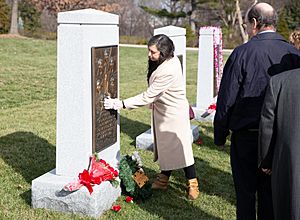
Judith Resnik was given the Congressional Space Medal of Honor after her death. She also received the NASA Space Flight Medal for her first flight. Many places and things are named after her. These include a dormitory at her university, Carnegie Mellon. There are also schools named after her in Maryland, Ohio, and Texas. A crater on the Moon and one on Venus are named in her honor. An asteroid, 3356 Resnik, also carries her name.
A memorial for Resnik and the Challenger crew is in Seabrook, Texas, where she lived. She is also remembered at the Space Mirror Memorial at the Kennedy Space Center. The Institute of Electrical and Electronics Engineers (IEEE) created the IEEE Judith A. Resnik Award in 1986. It honors people who make great contributions to space engineering. The Society of Women Engineers (SWE) also gives the Resnik Challenger Medal each year. It recognizes women who have changed the space industry with new technology.
The Challenger Center was started in 1986 by the families of the Challenger crew, including Judith's brother, Charles. Its goal is to get more children interested in science, technology, engineering and mathematics (STEM).
See also
 In Spanish: Judith Resnik para niños
In Spanish: Judith Resnik para niños


